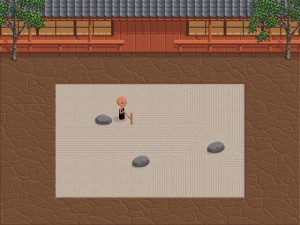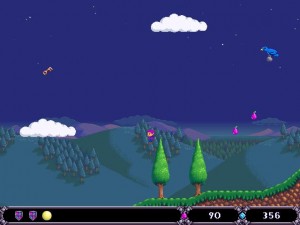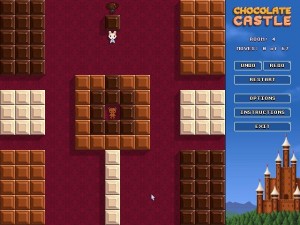I’m rather behind on my posting here, which interferes with my playing: I’m sworn to post per day for each game I play, which means that if I play a game and don’t post, I can’t play it again until I’ve posted. Usually this means I just don’t play anything from the Stack until I’ve written something, but something inspired me to play the three Lexaloffle mini-games I acquired from the most recent Humble Bundle in a row, one per day. I haven’t finished any of them, so let this be the introductory post for all three.
 The first one I tried was Zen Puzzle Garden. The goal here is to rake every grid-square of sand in a series of rock gardens, starting each stroke from the edge and using traditional videogame ice level movement mechanics, which is to say, you can’t change direction until you hit an obstacle, such as a rock or a tile you’ve already raked. I’ve completed somewhat over half the puzzles here, but the half I’ve completed is the easy half. It lets you play the puzzles in any order you want, choosing them from a grid between times, but if you play them in order, it takes a good long time to get at all difficult — so long that I began to wonder if there was going to be any real challenge to it at all. It’s certainly not obvious from the rules that there could be. Even in the later stages, I find some levels much easier than the ones around them. I think there may be some sort of parity issue, so that I sometimes luck into making moves with the right parity, but I haven’t analyzed it that deeply yet. If there is, then the levels with movable blocks presumably require you to move them to spots that make the parity come out right.
The first one I tried was Zen Puzzle Garden. The goal here is to rake every grid-square of sand in a series of rock gardens, starting each stroke from the edge and using traditional videogame ice level movement mechanics, which is to say, you can’t change direction until you hit an obstacle, such as a rock or a tile you’ve already raked. I’ve completed somewhat over half the puzzles here, but the half I’ve completed is the easy half. It lets you play the puzzles in any order you want, choosing them from a grid between times, but if you play them in order, it takes a good long time to get at all difficult — so long that I began to wonder if there was going to be any real challenge to it at all. It’s certainly not obvious from the rules that there could be. Even in the later stages, I find some levels much easier than the ones around them. I think there may be some sort of parity issue, so that I sometimes luck into making moves with the right parity, but I haven’t analyzed it that deeply yet. If there is, then the levels with movable blocks presumably require you to move them to spots that make the parity come out right.
 The second game I tried, Jasper’s Journey is a platformer about an elf rescuing a cat from a witch by throwing fruit at monsters. Or at least, picking up fruit replenishes your ammo. There’s a lot of collectibles scattered around, both fruit and treasure, the latter being spendable at the inns that appear once in each level. Now, I’ve only gotten three levels in, which is apparently still within the amount covered by the demo, so anything I say about the game’s general character may be dead wrong, but the parts I’ve seen have been made mostly of vast open spaces with lots of branching paths, including non-obvious ones that lead to more treasure and ammo. It reminds me of Sonic the Hedgehog in its expansiveness, but doesn’t emphasize speed or impose time limits. The emphasis is instead on exploration. When I found a passage leading to a large network of underground tunnels in level 2, I felt like I had made a discovery — even though it is in fact an unavoidable part of the main sequence through the level. Each level contains three golden orbs, their purpose unexplained by the in-game instructions. I think they unlock a bonus room between levels if you find them all, but their real purpose, their game-design purpose, is to give exploration a definite goal, and to let you know when you’ve explored enough. If you’ve got all three orbs, there probably isn’t anything left to find.
The second game I tried, Jasper’s Journey is a platformer about an elf rescuing a cat from a witch by throwing fruit at monsters. Or at least, picking up fruit replenishes your ammo. There’s a lot of collectibles scattered around, both fruit and treasure, the latter being spendable at the inns that appear once in each level. Now, I’ve only gotten three levels in, which is apparently still within the amount covered by the demo, so anything I say about the game’s general character may be dead wrong, but the parts I’ve seen have been made mostly of vast open spaces with lots of branching paths, including non-obvious ones that lead to more treasure and ammo. It reminds me of Sonic the Hedgehog in its expansiveness, but doesn’t emphasize speed or impose time limits. The emphasis is instead on exploration. When I found a passage leading to a large network of underground tunnels in level 2, I felt like I had made a discovery — even though it is in fact an unavoidable part of the main sequence through the level. Each level contains three golden orbs, their purpose unexplained by the in-game instructions. I think they unlock a bonus room between levels if you find them all, but their real purpose, their game-design purpose, is to give exploration a definite goal, and to let you know when you’ve explored enough. If you’ve got all three orbs, there probably isn’t anything left to find.
 Finally, there’s Chocolate Castle, which is a series of sliding block puzzles. The basic idea is that the fluffy animals on each level have to completely eat the enormous blocks of confectionery lying around. Each animal only eats blocks that match it in color, and only eats a single contiguous set of blocks before vanishing. In most levels, there’s only one animal of each color, so you have to put all the blocks of that color together before allowing it to feed. But you have to be careful about this, because once you put similarly-colored blocks together, they fuse permanently. This is a pretty rich ruleset, allowing for a great deal of variation in the practical goals. One level might be something like a traditional klotski; another might fill most of the playfield with blocks of just one kind of chocolate, with so little free space that your main challenge is to avoid fusing them prematurely; another might immobilize two pieces of chocolate with walls, and make you figure out how to bridge the gap between them. It makes for a much more appealing game than Zen Puzzle Garden, where the differences between levels are subtle and the goals are always the same.
Finally, there’s Chocolate Castle, which is a series of sliding block puzzles. The basic idea is that the fluffy animals on each level have to completely eat the enormous blocks of confectionery lying around. Each animal only eats blocks that match it in color, and only eats a single contiguous set of blocks before vanishing. In most levels, there’s only one animal of each color, so you have to put all the blocks of that color together before allowing it to feed. But you have to be careful about this, because once you put similarly-colored blocks together, they fuse permanently. This is a pretty rich ruleset, allowing for a great deal of variation in the practical goals. One level might be something like a traditional klotski; another might fill most of the playfield with blocks of just one kind of chocolate, with so little free space that your main challenge is to avoid fusing them prematurely; another might immobilize two pieces of chocolate with walls, and make you figure out how to bridge the gap between them. It makes for a much more appealing game than Zen Puzzle Garden, where the differences between levels are subtle and the goals are always the same.
All three games have a graphical style that reminds me a lot of early VGA games, from back in the days when the graphic artists suddenly had 256 colors instead of 16 and hadn’t figured out yet what to do with them. I don’t mean it’s clumsy or amateurish, exactly, but there’s something about the flatness of the palette. Chocolate Castle definitely makes the best use of it: the smooth sheen just makes the chocolate more delicious-looking.
 Fair or not, the effect is to make it seem like all the puzzles are more or less the same. Or, to put it more positively, like they’re all just instances of one big puzzle. Mathematical analysis really seems like the way to go here. I still haven’t really delved into that, beyond noticing a few patterns, local arrangements of tiles that correspond to solvability or nonsolvability. The most basic such pattern can be seen in the upper right corner of the board in this screenshot (although it’s too faint to be visible in the thumbnail): I’ve raked paths around a stone so that it lies in the inner corner. This makes it unsolvable. Consider the three tiles immediately to the north, northeast and east of the stone. Raking the north tile will necessarily involve going through the northeast tile, which will turn the east tile into a dead end. Likewise, raking the east tile will turn the north tile into a dead end. Either way, you’re stuck.
Fair or not, the effect is to make it seem like all the puzzles are more or less the same. Or, to put it more positively, like they’re all just instances of one big puzzle. Mathematical analysis really seems like the way to go here. I still haven’t really delved into that, beyond noticing a few patterns, local arrangements of tiles that correspond to solvability or nonsolvability. The most basic such pattern can be seen in the upper right corner of the board in this screenshot (although it’s too faint to be visible in the thumbnail): I’ve raked paths around a stone so that it lies in the inner corner. This makes it unsolvable. Consider the three tiles immediately to the north, northeast and east of the stone. Raking the north tile will necessarily involve going through the northeast tile, which will turn the east tile into a dead end. Likewise, raking the east tile will turn the north tile into a dead end. Either way, you’re stuck. Comments(0)
Comments(0)

